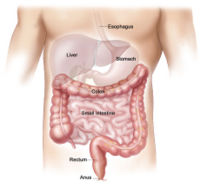Colon Cancer
 From Conservapedia
From Conservapedia Colon cancer is the third most common cancer in both men and women in the United States. It is the second-leading cause of cancer-related deaths in the U.S, with 50,000-60,000 people dying of it yearly.
Contents
- 1 Anatomy
- 2 Natural History & Prevention
- 3 Symptoms & Diagnosis
- 4 Treatment & Prognosis
- 5 References
Anatomy[edit]

The colon is the final portion of the digestive tract, after the small intestine. The anatomy of the colon is important in understanding cancer. The colon is usually considered to have 5 sections:
- ascending colon
- transverse colon
- descending colon
- sigmoid colon
- rectum
Cancers arising in different parts of the colon can cause different symptoms, and can metastasize, or spread, differently. Of special importance, cancers of the rectum have greater potential to spread to several parts of the body at once, while cancers from the rest of the colon tend to spread first to the nearby lymph nodes, and then to the liver.
Natural History & Prevention[edit]
Most colon cancer start off as benign colon polyps. As these polyps grow, the cells in them can become abnormal, and eventually cancerous. At some point after that, they can gain the ability to invade the rest of the body and metastasize to distant organs. The progression from polyp to invasive cancer usually takes about 10 years, making screening for the disease a life-saving procedure.
Most colon cancers arise after the age of 50, at which time screening is recommended. There are, however, several inherited types of colon cancer, the most important of which are hereditary nonpolyposis colorectal cancer (HNPCC) and Familial adenomatous polyposis (FAP). People with these conditions require earlier and more frequent screening. Also, people with Ulcerative Colitis are very susceptible to colon cancer and must be screened early and often.
For people without these conditions, and without a family history of colon cancer, screening usually begins at age 50. Your doctor will usually test your stool for hidden blood that may indicate a cancer or polyp, and most patients will be offered colonoscopy, where a long, thin tube with a camera on the end is used to examine the entire colon, and remove polyps if necessary.
Symptoms & Diagnosis[edit]
Many people with colon cancer have no symptoms at all. In people who do have symptoms, the most common ones are:
- Abdominal pain — 44 percent
- Change in bowel habit — 43 percent
- Bleeding from the rectum — 40 percent
- Weakness — 20 percent
- Anemia without other gastrointestinal symptoms — 11 percent
- Weight loss — 6 percent
Often, the only signs are blood detected in the stool by your doctor or a low blood count discovered on routine laboratory testing.
Treatment & Prognosis[edit]
Prevention is the most important factor in the prognosis and treatment of colon cancer. Most early tumors can be removed surgically and cured. Tumors that have spread require more aggressive therapy. Chemotherapy options are always changing, and cancer specialists keep up to date on the latest information.
References[edit]
- Jemal, A, Siegel, R, Ward, E, et al. Cancer statistics, 2006. CA Cancer J Clin 2006; 56:106.
- Speights, VO, Johnson, MW, Stoltenberg, PH, et al. Colorectal cancer: Current trends in initial clinical manifestations. South Med J 1991; 84:575.
- http://www.dana-farber.org/pat/cancer/gastrointestinal/gi-colorectal.asp
Categories: [Diseases] [Cancer]
↧ Download as ZWI file | Last modified: 02/27/2023 23:05:58 | 46 views
☰ Source: https://www.conservapedia.com/Colon_cancer | License: CC BY-SA 3.0
 ZWI signed:
ZWI signed: KSF
KSF